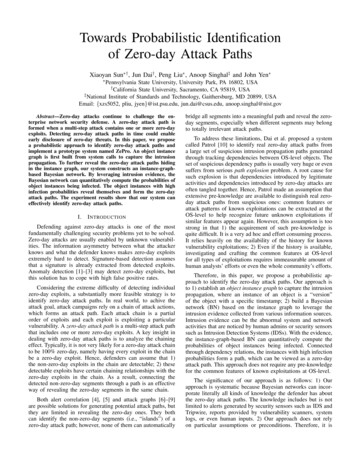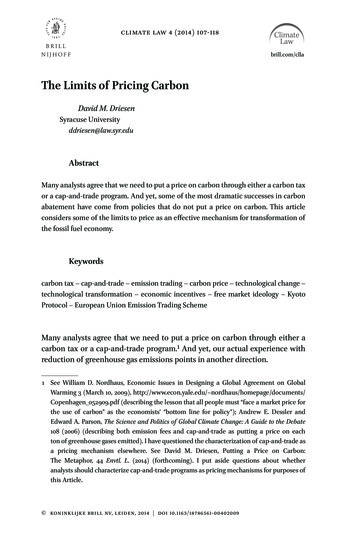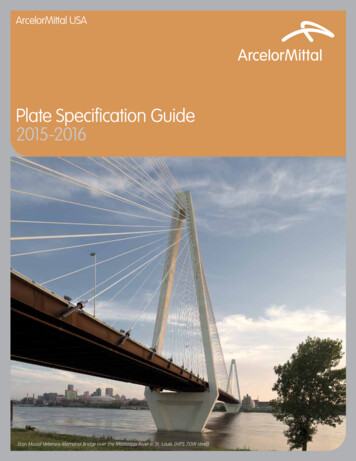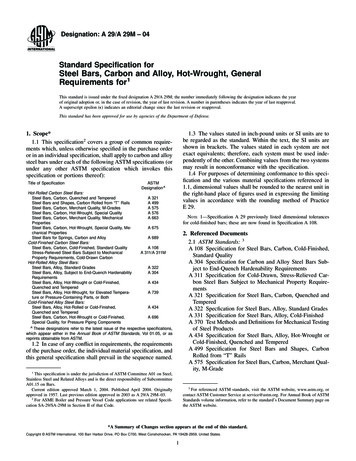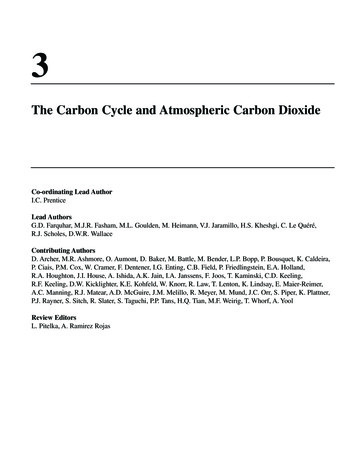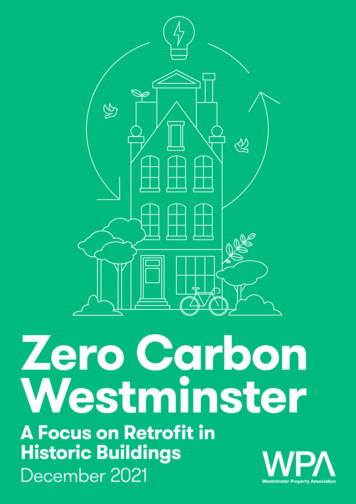
Transcription
Zero CarbonWestminsterA Focus on Retrofit inHistoric BuildingsDecember 20211
AcknowledgementsWestminster Property Association (WPA) is thenot-for-profit membership body and advocacygroup representing the leading owners, investors,professional advisors, and developers of realestate operating in the City of Westminster.This research paper has been produced with support fromconsultants Savills, JLL and Gerald Eve; engagement withpolicymakers at Westminster City Council; and authored bya steering group of sustainability and planning experts from theWPA membership:Tor Burrows, Grosvenor Britain & Ireland (Chair)Andrea Merrington, The Howard de Walden Estate (Vice Chair)James Burrage, Great Portland EstatesChris Cummings, SavillsJohn Davies, Derwent LondonRosie Day, WPAEdward Dean, LandsecRobin Everall, Oxford Properties GroupMark Hopkins, The Portman EstateKirsty Draper, JLLMichael Meadows, British LandAndy Mazzucchelli, LandsecMatt Richards, SavillsAbigail Shapiro, Oxford Properties GroupMatt Smith, ShaftesburyJane Wakiwaka, The Crown EstateSam While, Dolphin LivingJames Wickham, Gerald EveWe would also like to thank the following people for theircontributions to the development of this paper: Deirdra Armsby,Josephine Gay, Brendon Harper, Damian Hemmings, DrAmy Jones, Isobel Caton Harrison – Westminster City Council;David English, Tom Foxall, Emily Gee and Katie Parsons –Historic England; Amy Smith-Keary, University of Westminster;Alice Murphy – New West End Company23
ForewordIn the year since the Westminster Property Association publishedits Zero Carbon Westminster white paper on decarbonising thebuilt environment, the importance of tackling climate change hascome into even sharper relief.In August, the latest IPPC report left us in no doubt about theextreme impacts of climate change and the case for ambitiousaction. While last month, at the COP26 climate summit inGlasgow, we all witnessed national leaders grapple with thechallenges of tackling our greatest global threat.Here in Westminster, the Council was pleased to publish the firstiteration of a Climate Emergency Action Plan to kick start localaction and build a collaborative framework to achieve net zeroemissions across the city by 2040 together.There is no doubt that our ability to achieve this will depend onhow far we can reduce the energy demand of our buildings. Thisis particularly challenging in Westminster, where our heritagebuildings contribute so much to the unique character and pull ofthe city.This is where the WPA research report into retrofitting heritagebuildings is so vitally important: it demonstrates how buildingupgrades can both conserve these important historical assetsand adapt them to meet changing needs, whilst improving theirclimate resilience and sustainability.We recognise the role the council needs to play in enabling andsupporting these changes, and we are fully committed to playingour part. We will shortly be publishing our new EnvironmentalSPD which includes practical advice on a range of retrofitoptions, and we are upskilling all our staff on sustainability, withthe aim of becoming a recognised net zero leader on planningand the built environment.There is a huge opportunity for property owners and the Councilas a planning authority to work together to find creative waysto give our older properties a new lease of life in a zero-carbonfuture, and to ensure they can continue to enhance our city fordecades to come.We very much welcome this report and look forward to continuingto work closely with the WPA as together we face head-on thechallenge of making our buildings fit for a thriving, low carbonfuture.Amy JonesDirector for EnvironmentWestminster City CouncilIt makes clear the broad case for retrofit – including the noncarbon benefits of investment – and sets out the practicalinterventions that can be taken by property owners to achievethem.45
ForewordDespite the inevitable compromises, COP26, the recentinternational climate conference hosted in Glasgow, producedthe most progressive governmental pledges to date.The sheer volume of different voices in attendance, from youthdemanding change for their futures, to indigenous communitiessharing their experiences, was both sobering and motivating.This report provides a comprehensive and practical guide forproperty owners and policymakers, helping them navigate thechallenges of retrofitting heritage assets. By highlighting bestpractice examples, practical steps, policy and cultural changeswe can enable greater collaboration between owners, occupiers,planning authorities and stakeholders to deliver retrofit at thescale required.However, the discussions and commitments lack meaning if theyare not effectively converted into urgent action. For the UK toreach net zero by 2050, the property industry must play a keyrole in decarbonising the economy.I hope this guide will help support Westminster’s vision for acleaner, healthier and more sustainable future, whilst ensuring itretains its status as one of the UK’s most characterful and historicareas.In Westminster alone, the built environment contributes to 86% ofemissions, against a UK average of 40%, making this challengeuniquely pertinent to the area.While we can make new developments less impactful and moreenergy efficient, 80% of buildings that will exist in 2050 havealready been built. Therefore meeting net zero in Westminster,or anywhere, demands a clear strategy to decarbonise existingbuildings at an unprecedented rate, regardless of age orheritage. Taking a whole life approach considering operationaland embodied carbon will be vital.Tor BurrowsExecutive Director Sustainability &Innovation, Grosvenor Britain & Ireland.Chair, Westminster PropertyAssociation, Senior Advisory GroupFurthermore, the borough has the UK’s largest number of listedbuildings and the second highest concentration of any localauthority. Westminster’s historic buildings, a key part of itscharacter and identity, need to be sensitively adapted. Thiswill not only ensure these special places are resilient to climatechange but will also enable the emissions reductions we needwhilst preserving our history.67
Contents10Executive Summary14Introduction & Context22Unlocking delivery: recommendations for propertyownersPhysical interventions: ‘light touch’ measuresLessons learned from ‘deep’ retrofit projectsBehavioural change and occupier engagement23293745Planning policy and regulations: recommendationsfor icesA. Building typology analysisB. Mapping of heritage building typologies across the Cityof WestminsterC. Overview of light touch interventions – table ofinterventions and glossary of termsD. C ase studies of ‘deep retrofit’ projects in Westminster andits neighbouring areas9
Executive SummaryBold and ambitious action is needed from both property ownersand policymakers to enable heritage buildings to play a leadingrole in our collective fight against climate change – the greatestchallenge facing humankind.Retrofitting historic buildings to achieve a ‘Net Zero Carbon’(NZC) built environment is a significant opportunity forWestminster. The area has the largest number of listed buildingsin London, and the highest concentration of any local authorityin England – excluding the City of London’s Square Mile.90More than%of non-domesticproperties may requireupgrades before 2028More than 90% of non-domestic properties and almost halfof homes in Westminster which are privately rented mayrequire upgrades before 2028 to meet statutory requirements:creating risks of an unlettable building or a ‘stranded asset’ ifunaddressed.*The adaptation of heritage buildings is important in Westminster’sNZC journey. However, such interventions, especially ‘deep’retrofit projects, can incur high costs for the building owner, butthe business case for green investment is clear. Retrofittingfor sustainability can have material commercial benefits,including creating better-quality assets; future-proofing buildingsby aligning with increasingly ambitious regulations from localand national bodies; and mitigating against the risks of climatechange.We have identified common typologies of heritage buildingsin the City of Westminster with a particular focus on thosewhich have been converted to commercial: mid-18th Centurytownhouse; early to mid-19th Century townhouse**; andEdwardian institutional/commercial properties. This paper setsout the unique challenges and opportunities for retrofittingeach of these building typologies (Appendix A). The report alsoincludes general improvement interventions that will be commonacross all properties in Westminster.There is scope for implementing sustainable measures in allbuildings. Whilst every building is different, and there will beoccasions when a balance between retrofit and redevelopmentwill need to be made, adopting a retrofirst approach must bethe starting point if we are to help tackle climate change. Takinga whole life approach considering operational and embodiedcarbon will be vital.10Owners can also help minimise the emissions of their historicbuildings by implementing a range of measures, from low-costand ‘light touch’ interventions through to a comprehensiveor ‘deep’ retrofit.Image: Howard deWalden EstateWhile we encourage bolder action where possible, this paperexplores 12 key light touch measures (section 3ai and AppendixC) taking into account the cost, level of disruption to the buildingand improvement in energy efficiency. The paper sets out anumber of ‘easy wins’ for property owners to reduce theemissions of heritage buildings across asset classes.This report also sets out the lessons learned from six majoradaptation projects in or near Westminster, which havesuccessfully achieved a balance of heritage protection andsignificant environmental improvements (section 3aii andAppendix D).However, to help avoid a performance gap between how abuilding is designed and used, tenant engagement is vital. Thereport looks at the different key touch points of landlord/tenantengagement and provides advice on how to more effectivelyengage with occupiers at each stage to improve the building’soperational energy performance.Planning policy and regulation has significant implicationson the role that historic buildings can play in the fight againstclimate change. We have made a series of recommendationsfor both the relevant authorities and applicants to better enablecollaboration, the adaptation of buildings and the reduction ofcarbon emissions across Westminster’s older building stock. Minimum energy efficiency standards (MEES) of an EPC E rating of E by1 April 2023, potentially moving to a B rating by 2028. Changes to the EPCframework are currently under review. While these properties were originally designed as housing, many will havebeen converted to commercial use.11
3. Consider ‘deep’ retrofit of your buildings where possible. Werecommend that you: Consider embodied energy of deep retrofit measures Understand the building Understand the business case for taking positive steps toprotect and enhance heritage Get the project team right and start early Engage with Westminster City Council and Historic England Implement both established and new solutions to minimisecarbon emissions, mitigate climate change and avoid‘maladaptation’ Engage with your tenants and building management/facilities team Learn from and share your experiences4. When submitting your proposals to Westminster City Counciland Historic England: Provide early evidence that demonstrates the specificsustainability challenges and opportunities of the building,and how heritage protection is being taken into account Ensure all appropriate carbon saving interventions arethoroughly explored and justifiedOur key recommendationsFor property owners121. Establish Net Zero Carbon (NZC) pathways for everybuilding, ensuring all future refurbishment opportunitiesalign with a transition to NZC emissions. Undertake athorough assessment of the building from a sustainability andheritage perspective, including a calculation of the currentcarbon footprint, so that the range of retrofit options are wellconsidered in advance of discussions with WestminsterCity Council/Historic England. Use carbon offsetting asa last resort.2. Implement ‘light touch’ interventions for your buildingswhich can help improve the energy performance in a costeffective way, as a first step. Many of these technologiesand actions require minimal building intervention. This couldinclude: LED lighting Data monitoring Heating and cooling optimisation Considering ‘deeper’ interventions where appropriate,such as air source heat pumps Fabric interventions, e.g. insulation/secondly glazing5. Use the various ‘touch points’ (marketing, leasing, fit-outs,and on-going operation) as opportunities for the propertyowner, agent and occupier to engage and encouragebehavioural changes that would improve the building’ssustainability and operational energy performance. Someof the key principles are: Engage early Communicate clearly Provide support Recognise and maintain the on-going relationshipFor applicants,policy anddecision makersImage: Howard deWalden Estate Have due regard to Westminster’s new Environmental SPD Undertake a detailed assessment of the property in advance ofdiscussions with WCC/HE Make timely reviews of policy guidance to reflect best practice Recognise and put more emphasis upon the importance ofsustainability improvements when making planning decisions,alongside embedding and upskilling staff Introduce a ‘sustainability champion’ within the planningdepartment Provide training and CPD opportunities for staff to raiseawareness of the climate agenda and to ensure it is integratedacross the organisation Make greater use of Carbon Offset funds for retrofittingprojects13
Introduction & Context86%of Westminster’scarbon emissionscomes from the builtenvironmentWestminster City Council (WCC) has declareda climate emergency. The local authority haspledged that the City Council’s activities willbe carbon neutral by 2030, with the widercity following suit by 2040: 10 years aheadof UK Government targets. As identified in theCouncil’s ‘Climate Emergency Action Plan’1, thebuilt environment is the leading contributor tocarbon emissions – being responsible for 86% ofWestminster’s emissions.Both the City Council and Westminster’s property industry seekto deliver a Net Zero Carbon (NZC) built environment. This meansmaximising whole life carbon emission savings and responsiblyoffsetting any unavoidable emissions.Upgrading heritage buildings to reach improved energy andsustainability standards is critical to achieve this ambition, as isclimate change mitigation.The maintenance and adaptation of heritagebuildings is vital in Westminster’s fight againstclimate change. However, planning and regulatoryrequirements need to have greater regard forlow carbon and low energy interventions. Suchinterventions can incur high costs for the buildingowner, which are difficult to justify at a time ofpost-Covid economic uncertainty.The WPA believes that the business case for green investmentis clear. A ‘climate first’ approach to upgrading buildings hasmaterial commercial benefits, including creating better qualityassets, attracting green finance, driving occupier interest andfuture-proofing buildings by aligning with increasingly ambitiousrules from national and local bodies – and therefore avoidinghaving a costly ‘stranded asset’. Please refer to WPA’s ZeroCarbon Westminster report for further reading.In this section, we explain the scope and objectives of the report;set out the scale of the opportunity for retrofitting Westminster’sheritage building stock; and list the three most commontypologies of heritage buildings.14Westminster is home to an exceptional range, quality andnumber of historic buildings which contribute to the City’seconomy, character and environment. There are sensitivities toovercome when adapting heritage buildings. High upfront costsand sensitive navigation through planning policies are sharedfactors for the City Council and WPA members. To achieve abalance between heritage protection and climate resilience,creative collaboration between industry and the public sector isessential.This research report identifies opportunities and proposesrecommendations to enable Westminster’s heritage buildings toplay their part in reducing the carbon impact of Westminster’sbuilt environment in our shared fight against climate change– whilst enabling owners to protect and enhance their historicassets. It aims to build upon WCC’s ambitious climate actionstrategy and policymaking, such as the draft EnvironmentalSupplementary Planning Document(SPD)2, and the existingadvances towards these goals by WPA members.The potential impact is huge. A recent paper3 by GrosvenorBritain & Ireland showed that the energy efficiency opportunityof listed buildings and unlisted historic dwellings in conservationareas in England and Wales would equate to approximately5% of the UK’s total carbon emissions associated with the builtenvironment.15
This carbon saving opportunity is expected to be much higher inthe City of Westminster, which has the highest concentration oflisted buildings of any local English authority (after the City ofLondon).The report is aimed at two primary audiences: Westminster’sproperty industry, represented by WPA members; and thepolicymakers and decisionmakers at Westminster City Counciland Historic England. We would also welcome engagement anddiscussion of our ideas with a wider network of stakeholders,including local residents, businesses and other statutory bodies.As the majority of WPA members are involved withcommercial real estate, we have focused on these types ofbuildings – including older residential properties convertedfor offices, retail and hospitality uses. However, the large-scaleupgrading of Westminster’s housing stock will be necessary forachieving WCC’s NZC ambitions, and so we have included anumber of case studies and recommendations which apply toresidential landlords.16Image: 119 Ebury Street17
Opportunities and challenges forretrofitting Westminster’s heritage54%54% of Westminster’s buildings have anEPC (energy performance certificate)* ratingof C or below: meaning these buildings requireupgrades before 2028A.4%4% of the City’s total building stockhas an EPC rating of F or below: an energyperformance rating so poor that residentialproperties can’t be let - creating the risk of a‘stranded asset’A7xWestminster has the highest number oflisted buildings of any London localauthority: more than double that of closestborough (Camden) and almost seven timesthe London averageC1892%*92% of non-domestic properties and 48%of homes have an EPC rating of C or below.This rises to 99% when looking at homes with aheritage listingB81KMore than 81,000 buildings rely on gasboilers for heating. That equates to18,800,000m2 of floorspace which requiresswitching to electric heating if we are tomeet WCC’s NZC ambitionsA1156kWestminster has 11,000 listed buildingsand structuresD86%86% of Westminster’s carbonemissions are produced from the energyused in our homes, hospitals, shops,offices, hotels and other buildingsE56 conservation areas cover 78% of theCity’s footprint CSourcesA: Analysis by Savills, based on a sampleof 115,000 buildings across the City ofWestminsterB: Analysis by Savills, based on a sampleof 1,939 buildings across the City ofWestminster (1,456 of which are domestic)C: Historic England data analysed by WPA4D: Westminster City Plan, 2019-20405E: Westminster City Council ClimateEmergency Action PlanpersqmWestminster has the largest number of listedbuildings per sq kmof any English local authority*C* Excluding the City of London, which is asingle square mile.* We acknowledge that EPCs are an imperfect measureand welcome new methodologies for understandingbuilding performance.19
Heritage typologiesIn this paper we are defining heritage buildings as thosewhich are listed, or are older properties within conservationareas. To help identify common issues and potential carbonsaving measures for this research, Savills has set out the threemost common typologies of heritage buildings in the City ofWestminster. While a significant proportion of these propertieswere originally designed as housing, many will have beenconverted to commercial use.Common challenges– Improving window performance– Retrofitting/upgrading heating andelectrical systems– Installing appropriate renewableenergy generationCommon opportunities– Improving insulation– Installing low energy lighting– Considering air or ground source heatpumps for heatingMid-18th Century townhouseExample: Chandos House (Grade I listed);Harley Street Conservation AreaUnique challenge/opportunityLoss of traditional windows is seen as a majorthreat by Historic England. Shutters can bereinstated for improving thermal performance.20Early to mid-19th CenturytownhouseExample: 83-102 Eaton Square (Grade II* listed);Belgravia Conservation AreaUnique challengeImproving the thermal performance of windowsand roof.Edwardian institutional andcommercialThere is a more detailed analysis ofthese typologies, including their uniquechallenges and opportunities for retrofitset out in Appendix A and a mapof their geographic locationsin Appendix B.Example: 106-130 Regent Street (Grade II listed);Regent Street Conservation AreaUnique challengeRetention of historic fabric and layout.21
Unlocking delivery:Recommendationsfor property ownersTo help reduce the carbon emissions associated withWestminster’s building stock, property owners shouldcalculate the carbon footprint and establish NZC pathwaysfor all their buildings that respond to their unique needsand opportunities – and ensure all future refurbishmentopportunities align with a transition to NZC emissions. Forfurther advice on this, see WPA’s Zero Carbon Westminster6report and Better Buildings Partnership’s Net Zero CarbonPathway Framework7.The energy efficiency and sustainability of heritage buildingscan be improved through a range of actions, from low-cost and‘light touch’ interventions, through to a comprehensive or ‘deep’retrofit. In addition, tenant engagement is vital if we are to makesure that retrofitted spaces are used efficiently and effectively.This will help avoid the so-called ‘performance gap’ betweenbuilding design and use.Following the previous analysis of the scale of the challenge, andan understanding of the most common building typologies inWestminster, we explore ways for landlords to ‘unlock delivery’.This section of the report sets out recommendations for propertyowners to:Light touch interventionsOther8%Hot water8%Lifts3%HVAC40%Equipment22%Lighting22%– As a first step, implement light touch retrofit measures takinginto account the cost, level of disruption to the building, andimprovement in energy efficiency. The 12 recommendationsinclude ‘easy wins’ for landlords to reduce the emissions ofheritage buildings across asset classesThis pie chart shows the typical breakdown of energy use* in amixed-use office and retail building. As you can see, there is arelatively even split between heating and cooling (HVAC) andelectrical loads (lighting and other equipment).– Consider lessons learned from six major adaptation projectsin or near Westminster, which have successfully achieved abalance of heritage protection and significant environmentalimprovements. Strive for bold ambition that responds to theneeds and opportunities of your historic buildingsWith this understanding, the following table sets out 12 low-costinterventions that can reduce energy and carbon emissions in atypical building focusing on lighting, heating and cooling. It alsoexplores opportunities for building performance improvementthrough monitoring, and where appropriate, fabric interventionsand other ‘deeper’ interventions.– Engage more effectively with occupiers across four keytouch-points in the building leasing process; encouragingbehavioural change that improves a building’s operationalenergy performanceThe interventions have been selected by JLL and rated with ared, amber or green ranking to reflect their overall effectivenessin energy/carbon reduction relative to cost and ease ofimplementation.Given the pace of technological change, where possible, anytechnology implemented into a building should be specifiedto have an ‘open’ API (Application Programming Interface) to2223
allow the future integration of new technology that may assistin generating even greater energy and carbon savings. Propertyowners should follow a process of implementing measures thatmaximise the building’s overall efficiency, for example, makingimprovements to the building fabric ‘first’ through insulation(where appropriate) before introducing new heating and coolingtechnologies.*The majority of this energy usage would be within a property’s‘lettable space’ e.g. retail units, workspaces, and meeting rooms.This makes occupier engagement and behavioural change(see section 3c) of utmost importance and should be prioritisedalongside any physical interventions.A more detailed table including further technical information onthe benefits and steps required for implementation is providedat Appendix C; there are recommended measures set out inWCC’s draft Environmental SPD8 and Historic England providesguidance as to whether or not interventions typically requirelisted building consent or not9.Light touch interventionTypologyImpactEase of applicationCost*RatingUpgrade all internal lighting to LEDCommercial & residentialUp to 75% energy saving compared toolder lighting systems.Straightforward to implement inlandlord areas. Occupiers incentivisedto co-operate by reduced energy costs.Low – average costs per LED bulb isaround 15- 20 while LED tubes wouldbe between 20- 30.Cost effective relative to energy savingand simple to implement.Install PIR sensors to control lightingPredominantly commercial, but usefulfor residential common parts5-30% energy saving - user dependent.Easy to implement in Landlord areas.Building-wide approach will requireoccupier co-operation.Average costs per PIR sensor circa 35- 150 depending on type andmanufacturer.Cost effective relative to energy saving,especially if implemented with lightingupgrade.Install Automated Meter Reader(AMR) on main incoming meters to allowuse data to be collected.Commercial &ResidentialAMRs collect accurate energy dataand can enable users to identifyopportunities for energy reduction. E.g.turn systems off when not required.Easy – can be implemented withminimal disruption.Upgrading main (landlord) meters toAMRs would cost 500 - 1,000 permeter – some energy suppliers embedthis into ongoing service.Low expense for output – value of datain reducing energy use is high.Install AMR sub-metersCommercial & residentialImproves quality of data collectionand provides a platform from whichto engage with key stakeholders andoccupiers.Easy to implement on landlord mainplant. Harder to implement in occupiedareas, though potential energy costssavings is a useful incentive.Submeters cost circa 350 - 500depending on type and manufacturer.Low expense, but ease ofimplementation depends on occupierco-operation. Higher quality data helpsto drive further energy savings.CO2 sensorsInstall on air handling units so fresh airis provided when required, rather thanat all times.Commercial –Not applicable for residential propertiesas it will not have an impact on energyefficiency.Contributes to energy savings throughoperational optimisation and alsomakes this process simpler and moreaccurate.Easy to implement on landlord mainplant, but requires occupier cooperation for tenanted areas.Cost per CO2 sensor is circa 250.Provides higher accuracy in optimisingsystem at relatively low cost – reducesenergy use by providing fresh airwhen needed, rather than constantly,regardless of occupation levels.Smart building platformAllows for BMS analyticsCommercial & Residential, though relieson property having BMS installedContributes to achieving the 5-20%savings produced by the abovemeasures by maximising efficiency ofsystems.Easy and can be implemented withminimal disruption, so long as existingBMS is in place.Cost varies, but typically equates tocirca 1.30 / m2. (annual licence cost)depending on which platform is used.Smart building platforms are relativelycheap and can often be embeddedinto the service charge as it falls underimproving building operation.Building Energy ManagementSystems(BEMS analytics)Commercial & Residential, though relieson property having a metering systeminstalledContributes to achieving the 5-20%savings produced by the abovemeasures by maximising efficiency ofsystems.Easy and can be implemented withminimal disruption.Costs depending on number of meters,and on average would be around 100- 200 per meter or supply (ongoing annual fee) depending on whichplatform is used.Energy Management Systems arerelatively cheap and can oftenbe integrated into the propertymanagement agreement or servicecharge.LightingMonitoring** All costs and rating have been evaluated based on return on investment and are based on an example assetof 25,000 m2 GLA. The costs presented do not include any tendering processes, design or consultancy fees2425
Light touch interventionTypologyImpactEase of applicationCostRatingCommercialUp to 25-30% reduction in HVAC energyload.Easy and can be implemented withminimal disruption.Assuming BMS system is in place, costis minimal given most adjustments canbe implemented by M&E maintenanceteams. However, software upgrade costsfor Demand based ventilation and BMSstrategies would be around 18,000and 15,000, respectively.Cost efficient and high level of energysaving potential.In comparison to other light touchinterventions, the cost associated withinstalling a hea
buildings by implementing a range of measures, from low-cost and 'light touch' interventions through to a comprehensive or 'deep' retrofit. While we encourage bolder action where possible, this paper explores 12 key light touch measures (section 3ai and Appendix C) taking into account the cost, level of disruption to the building

